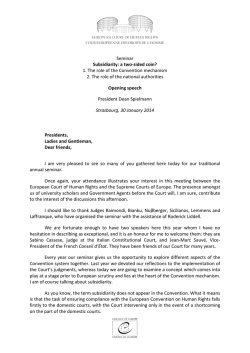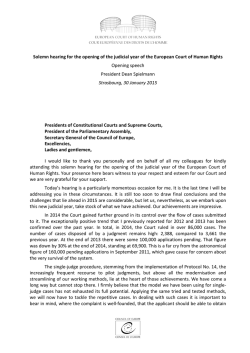
Seminar Background Paper 2015 - European Court of Human Rights
Seminar to mark the official opening of the judicial year Subsidiarity: a two-sided coin? 1. The role of the Convention mechanism. 2. The role of the national authorities. Background paper 1 30 January 2015 1. Prepared by the Organising Committee, chaired by Judge Laffranque and composed of Judges Raimondi, Bianku, Nuβberger and Sicilianos, assisted by R. Liddell of the Registry. This paper which does not reflect the views of the Court is intended to provide a framework for the rapporteurs and a basis for the seminar discussions. 1 I. Introduction 1. That the notion of subsidiarity is deeply embedded in the European Convention on Human Rights (“the Convention”) has been recognised by the European Court of Human Rights (“the Court”), and before it the European Commission of Human Rights (“the Commission”), since the early days of the Convention mechanism. Thus in the Belgian Linguistic Case in 1968 the Court first referred to the “subsidiary nature of the international machinery of collective enforcement established by the Convention”.2 Indeed it is a defining characteristic of the Convention structure as reflected in the Strasbourg case-law in particular with regard to the relationship between the international system of human rights protection and national jurisdictions. 2. While the Convention in its present version contains no express reference to subsidiarity, it does provide a legal framework for its operation. Firstly Article 1 requires the High Contracting Parties to secure to everyone within their jurisdiction the rights and freedoms set out in the Convention. This requirement is reinforced by Article 13 which stipulates that States must provide an effective remedy for violations of the Convention rights and freedoms. Secondly under Article 35 § 1 the Court is prevented from dealing with an application before all domestic remedies have been exhausted. Reference may also be made to Article 53 which expressly recognises that Contracting States may go further than the Convention in the protection offered. Subsidiarity is also present by implication in many of the substantive articles of the Convention, in particular those which allow for restrictions on the protected rights and freedoms. In short, and in its simplest form, subsidiarity as expressed in the Convention comprises two elements: an obligation for the States to implement the Convention guarantees, this being an obligation of result rather than means, and an obligation for the Court to allow the national authorities to have the fullest opportunity to address a Convention complaint, however grievous, before it can examine the matter itself. 3. However, subsidiarity has evolved into a much more sophisticated doctrine, covering not just the possibility of review, but its intensity, through the development of notions such as the margin of appreciation and the “fourth-instance” rule. Again this affects not only the way in which the Court should conduct its review but also the way in which States are expected to perform their obligations. II. The 2012 Brighton Conference and Protocol No. 15 4. The High Level Conference on the future of the European Court of Human Rights held at Brighton followed on from two earlier conferences on the same theme at Interlaken and Izmir.3 At all three conferences great emphasis was placed on the principle of subsidiarity, while the principle’s two-sided nature was reaffirmed. This was also expressed as the shared responsibility for the system between the States and the Convention mechanism. 4 The Brighton declaration indicated that “the States 2. Belgian Linguistic (merits), judgment of 23 July 1968, Series A no. 6, p. 35 § 10 in fine. 3. Respectively on 18 and 19 February 2010 and 26 and 27 April 2011. 4. See for example point 3 of the Interlaken declaration and point 6 of the Izmir declaration. 2 Parties and the Court share responsibility for realising the effective implementation of the Convention, underpinned by the fundamental principle of subsidiarity”.5 The Conference declared “that the High Contracting Parties, in accordance with the principle of subsidiarity, have the primary responsibility to secure the rights and freedoms defined in this Convention and the Protocols thereto, and that in doing so they enjoy a margin of appreciation, subject to the supervisory jurisdiction of the European Court of Human Rights established by this Convention”. As a consequence of the Conference’s recommendation Protocol No. 15 which was opened for signature on 24 June 2013, inserts a new recital into the Preamble of the Convention as follows: “Affirming that the High Contracting Parties, in accordance with the principle of subsidiarity, have the primary responsibility to secure the rights and freedoms defined in this Convention and the Protocols thereto, and that in doing so they enjoy a margin of appreciation, subject to the supervisory jurisdiction of the European Court of Human Rights established by this Convention, (...)”. 6 It has been suggested that this inclusion has ushered in an “age of subsidiarity”. 7 5. The duality of the principle of subsidiarity is the recurring theme of the Brighton Declaration. Thus on the one hand it recognises the responsibility of States not just to implement Convention guarantees effectively but also to provide appropriate remedies. It indicates that “All laws and policies should be formulated, and all State officials should discharge their responsibilities, in a way that gives full effect to the Convention. States Parties must also provide means by which remedies may be sought for alleged violations of the Convention. National courts and tribunals should take into account the Convention and the case law of the Court”.8 On the other hand it recalls the importance of the margin of appreciation 9 and the need to apply strictly the admissibility criteria. 10 It also calls upon the Court to declare inadmissible as manifestly unfounded a complaint that has been duly considered by a domestic court applying the rights guaranteed by the Convention in light of well-established case-law of the Court including on the margin of appreciation, unless the application raises a serious question affecting the interpretation or application of the Convention.11 6. In this way the Brighton Declaration establishes a template for what it considers to be the respective roles of the States and the Convention machinery. This paper will consider first the role of the Convention mechanism, before turning to that of the national authorities. Inevitably, however, there is a considerable degree of overlap between the two roles. The paper will not focus on the question of subsidiarity in the context of execution of the Court’s judgments since this was dealt with at the 2014 seminar. 12 5. Point 3 of the Declaration. 6. Article 1 of the Protocol. 7. Robert Spano, Universality or Diversity of Human Rights, Human Rights Law Review (2014) 14 (3): 487-502. 8. Point 7 of the Declaration. See also point 9 for more specific recommendations. 9. Point 11 of the Declaration. 10. Point 14 of the Declaration. 11. Point 15 d. of the Declaration. 12. The proceedings of the seminar may be consulted on the Court’s website: http://www.echr.coe.int/Pages/home.aspx?p=court/events&c=#n13914275017812268744581_pointer 3 III. The role of the Convention mechanism 7. Subsidiarity places constraints on the Convention mechanism and therefore qualifies its role by limiting the scope of the Court’s review. The limits are both procedural and substantive. A. Procedural subsidiarity 8. The major procedural element of subsidiarity is the obligation to exhaust domestic remedies under Article 35 § 1 of the Convention. In the recent Grand Chamber judgment of Vučković and Others v. Serbia 13, the Court recalled the general principles applicable to exhaustion in the following terms: “It is a fundamental feature of the machinery of protection established by the Convention that it is subsidiary to the national systems safeguarding human rights. This Court is concerned with the supervision of the implementation by Contracting States of their obligations under the Convention. It should not take on the role of Contracting States, whose responsibility it is to ensure that the fundamental rights and freedoms enshrined therein are respected and protected on a domestic level. The rule of exhaustion of domestic remedies is based on the assumption – reflected in Article 13 of the Convention, with which it has close affinity – that there is an effective remedy available in respect of the alleged violation. The rule is therefore an indispensable part of the functioning of this system of protection.” 9. From the applicant’s perspective Article 35 § 1 requires that the complaints intended to be brought subsequently to Strasbourg should have been made to the appropriate domestic body (and in compliance with the formal requirements and timelimits laid down in domestic law) and, further, that any procedural means that might prevent a breach of the Convention should have been used. Applicants are not, however, required to invoke the Convention right relied on expressly in the national proceedings. It is enough to raise the issue in substance or implicitly. 14 10. Another aspect of procedural subsidiarity may be seen in Article 35 § 3 (b) according to which an application may be declared inadmissible where the applicant has not suffered a significant disadvantage. There are at present two safeguard clauses, one referring to respect for human rights requiring an examination of the application on the merits and the other to the effect that no case may be rejected on this ground which has not been duly considered by a domestic tribunal. The second safeguard clause is however to be deleted under Protocol No. 15.15 13. Vučković and Others v. Serbia [GC], no. 17153/11, §§ 69-77, 25 March 2014. 14. See for example Azinas v. Cyprus [GC], no. 56679/00, ECHR 2004-III, § 38. 15. Article 5 of the Protocol. 4 B. Substantive subsidiarity 11. Substantive subsidiarity is most clearly expressed in two doctrines which the Court has developed. The first is the so-called fourth-instance rule and the second and most important is the doctrine of the margin of appreciation. i. Fourth instance rule 12. Under the fourth-instance rule the Court considers that it has only limited jurisdiction to verify that domestic law has been correctly interpreted and applied and that it is not its function to take the place of the national courts, its role being rather to ensure that the decisions of those courts are not flawed by arbitrariness or otherwise manifestly unreasonable. 16 It is not, as the Court has repeatedly held, its function to deal with errors of fact or law allegedly committed by a national court unless and in so far as they may have infringed rights and freedoms protected by the Convention. 17 The Court has also found that the interpretation of European Union law by national courts falls outside its jurisdiction. 18 13. The fourth instance rule operates properly in a purely judicial context and relates to the assessment of facts and national law by the national courts. The most obvious example is a complaint under the Article 6 fair trial guarantee that is directed against the outcome of the proceedings rather than a defect in the proceedings which have led to that outcome and which may be such as to render those proceedings unfair in Convention terms. In this context the Court will not normally interfere with findings of fact or interpretation of national law unless they are of an obviously arbitrary character. 14. On the other hand in relation to situations where the assessment of facts and law by the national courts may itself be constitutive of a Convention breach (for example under Articles 8 and 10), the Court’s review will extend into these areas. Here the Court has expressed its relationship with the superior national courts as follows: “Where ... the superior national courts have analysed in a comprehensive and convincing manner the precise nature of the impugned restriction, on the basis of the relevant Convention case-law and principles drawn therefrom, this Court would need strong reasons to differ from the conclusion reached by those courts by substituting its own views for those of the national courts on a question of interpretation of domestic law ...”. 19 15. Moreover where it is part of the Convention guarantee that national law must be complied with, as for example under Article 5 § 1 which requires detention to be 16. 17. 18. 19. Anheuser-Busch Inc. v. Portugal, no. 73049/01, § 83, 11 October 2005. García Ruiz v. Spain [GC], no. 30544/96, ECHR 1999-I, § 28. Ullens de Schooten and Rezabek v. Belgium, nos. 3989/07 and 38353/07, § 66, 20 September 2011. Roche v. the United Kingdom [GC], no. 32555/96, ECHR 2005-X, § 120. 5 lawful, the Court can and should review whether national law has in fact been complied with.20 ii. Margin of appreciation 16. As regards the margin of appreciation, the first clear statement of the doctrine appears in the well-known passage in the Handyside judgment.21 It has been the subject of lengthy study and debate ever since 22 and the Court has continued to make frequent reference to it. The margin of appreciation can be seen as a sort of “lex specialis” in relation to the general principle of subsidiarity. 23 Under it, as under the broader principle of subsidiarity, the Court recognises that both as a matter of principle and in practice the national authorities are better placed to make the assessment of the necessity and proportionality of measures restricting the Convention rights and freedoms. The Court accordingly exercises a degree of selfrestraint which reflects the area of discretion or margin of appreciation which national authorities enjoy. 17. The margin of appreciation recognises that in applying certain Convention guarantees there may be a range of different but legitimate solutions depending on the context, and especially in relation to assessing the proportionality of a permitted limitation on a right or freedom or striking a balance between competing rights. The margin of appreciation extends not just to judicial review; it also acknowledges the weight to be attached to the democratic process and the range of options that may be available to legislators in complying with the Convention. 24 As the Court has observed, “the national authorities have direct democratic legitimation and are in principle better placed than an international court to evaluate local needs and conditions. In matters of general policy, on which opinions within a democratic society may reasonably differ widely, the role of the domestic policy-maker should be given special weight”. 25 18. There are however some key areas in which the margin of appreciation has no role. For example the question whether or not facts found to be established attain the level of severity to attract the protection of Article 3 prohibiting torture and inhuman or degrading treatment cannot come within any margin of appreciation. Nor in the light of the absolute nature of that prohibition is there any room for balancing 20. Mooren v. Germany [GC], no. 11364/03, §§ 72 et seq. 21. Handyside v. the United Kingdom, judgment of 7 December 1976, Series A no. 24, §§ 49-50. The term or variations of it were first used by the European Commission of Human Rights in its report in Greece v. United Kingdom, application no. 176/56, 26 September 1958. 22. See Dean Spielmann, “Allowing the right margin of appreciation. The European Court of Human Rights and the national margin of appreciation doctrine: Waiver or subsidiarity of European review?” CambridgeYearbook of Legal Studies, 2011-2012, Volume 14, pp. 381-419, and in particular footnote 8. 23. J. Christoffersen, “Fair balance: Proportionality, Subsidiarity and Primarity in the European Convention on Human Rights, International Studies in Human Rights, vol. 99, Martinus Nijhoff, Leiden 2009. 24. See Animal Defenders International v. the United Kingdom [GC], no. 48876/08, § 115-116, ECHR 2013 (extracts). 25. S.A.S. v. France [GC], no. 43835/11, § 129, 1 July 2014. 6 competing interests such as national security against the risk of ill-treatment or torture.26 19. It has long been clear that the width of the margin varies according to the nature of the interest whose protection is claimed. Thus for example in relation to freedom of expression, the margin will be narrow in respect of restrictions on political speech and wider in connection with speech which offends personal convictions within the sphere of morals or religion or with regard to the regulation of commercial speech. 27 20. Another factor which may determine the width of the margin of appreciation is the existence or lack of “consensus” at European level. In other words where there is evidence of a common approach among other Convention States, the margin of appreciation to adopt a different approach which is more restrictive of Convention rights and freedoms will in principle be more limited.28 In this context the Court has also recognised the existence of a “clear trend” 29 or a “distinct tendency”. 30 21. The scope of the margin of appreciation may be more extensive where the national authorities are balancing competing Convention rights. The Court has held that where a respondent State had to balance two competing interests which were both protected by the Convention it benefits from a wide margin of appreciation.31 Here the Court has spelt out both the limits on its own jurisdiction and what was expected of the national courts. Thus it considered that “where the balancing exercise had been undertaken by the national authorities in conformity with the criteria laid down in the Court’s case-law, the Court would require strong reasons to substitute its view for that of the domestic courts”. 32 22. Whatever disagreement there may be about the precise scope and impact of the margin doctrine, the Explanatory Report to Protocol No. 15 makes clear that the reference to subsidiarity and the margin of appreciation in the Preamble “is intended to ... be consistent with the doctrine of the margin of appreciation as developed by the Court in its case law” (emphasis added). In other words the fact of inserting a reference to the doctrine in the Preamble does not fundamentally alter its character as a jurisprudential construct. However, unquestionably the Contracting States wished to send a strong message to the Court. 23. In conclusion with regard to the Strasbourg machinery’s role, subsidiarity is a crucial component of the Convention system which provides the interface between the 26. Among other authorities, Chahal v. the United Kingdom, 15 November 1996, § 79, Reports 1996-V. 27. For example Mouvement raëlien suisse v. Switzerland [GC], no. 16354/06, § 61, ECHR 2012 (extracts). 28. For a recent study of consensus, see Wildhaber, Hjartarson and Donelly “No consensus on consensus? The practice of the European Court of Human Rights”, Human Rights Law Journal, 31.12.2013, vol. 33, no. 7-12. 29. M.C. v. Bulgaria, no. 39272/98, § 156, ECHR 2003-XII. 30. Mazurek v. France, no. 34406/97, § 52, ECHR 2000-XI. 31. Neij and Sundi Kolmisoppi v. Sweden, no. 40397/12, 19 February 2013, the so-called “Pirate bay case”). 32. MGN Limited v. the United Kingdom, no. 39401/04, §§ 150 and 155, 18 January 2011. 7 international and national jurisdictions. The Court’s side of the subsidiarity coin entails a clear responsibility to draw appropriate conclusions from effective implementation at national level. Indeed it is in doing just that that it can provide an incentive to national authorities to fulfil properly their Convention role thereby allowing the Court’s review to be less intrusive. IV. The role of the national authorities 24. Handyside confirms the division of labour 33 deriving from the subsidiary character of the machinery set up by the Convention. Thus “the Convention leaves to each Contracting State, in the first place, the task of securing the rights and liberties it enshrines. The institutions created by it make their own contribution to this task but they become involved only through contentious proceedings and once all domestic remedies have been exhausted”. 34 25. Under this division of labour the Contracting States have two main obligations. The first is to ensure that the rights and freedoms set out in the Convention are adequately protected. In other words, they must put in place the structures and procedures necessary to secure in practice the rights and freedoms guaranteed by the Convention (Article 1 of the Convention). The second is to provide a remedy when that protection breaks down. Enshrining a right in national law is not sufficient; it must be possible to secure redress at national level. This is the requirement under Article 13 to provide an effective remedy before a national authority. A. Guaranteeing rights (the substantive dimension) 26. It is clear that one aspect of the first obligation is legislative. Thus the Brighton Declaration calls upon governments in particular to implement practical measures to ensure that policies and legislation comply fully with the Convention, including by offering to national parliaments information on the compatibility with the Convention of draft primary legislation proposed by the Government.35 The setting up of Parliamentary committees tasked with scrutinizing draft legislation for Convention compatibility can play an important part in this respect. Such committees have been set up for instance in the United Kingdom, the Netherlands and Poland. The Parliamentary Assembly of the Council of Europe (PACE) has called on “all member states to provide for adequate parliamentary procedures to systematically verify the compatibility of draft legislation with Convention standards and avoid future violations of the Convention, including regular monitoring of all judgments which could potentially affect the respective legal orders”.36 33. This expression is used by Gertrude Lübbe-Wolff, “How can the European Court of Human Rights reinforce the role of the national courts in the Convention system?”, 32 Human Rights Law Journal 11, at 12 (2012) 34. Handyside v. the United Kingdom, cited above, see § 48. 35. Brighton Declaration at 9 c) ii. 36. PACE Resolution 1823 (2011). 8 27. The Court will also take account of the quality of the parliamentary process in assessing the width of the margin of appreciation. Thus the Court expressed this idea as follows in the Animal Defenders case: “ ... in order to determine the proportionality of a general measure, the Court must primarily assess the legislative choices underlying it .... The quality of the parliamentary and judicial review of the necessity of the measure is of particular importance in this respect, including to the operation of the relevant margin of appreciation.” 37 In that case, which concerned the prohibition of political broadcasting, the Court noted that the Act containing the prohibition was enacted with cross-party support and without any dissenting vote. The prohibition had therefore been “the culmination of an exceptional examination by parliamentary bodies of the cultural, political and legal aspects of the prohibition as part of the broader regulatory system governing broadcasted public interest expression in the United Kingdom and all bodies found the prohibition to have been a necessary interference with Article 10 rights”. 38 Where therefore parliament engages in a comprehensive review of the Convention issues at stake and conducts a balancing exercise of the relevant competing interests in the light of Convention case-law, they are carrying out their true mission under the Convention and the Court’s scrutiny will be tailored accordingly. 28. In addition to the negative obligation not to introduce legislation which interferes with Convention rights the Court has developed the concept of positive obligations which require that in some circumstances national authorities must take positive action to ensure the effective enjoyment of Convention rights. Thus for example “[Article 8] does not merely compel the State to abstain from such interference: in addition to this primarily negative undertaking, there may be positive obligations inherent in an effective ‘respect’ for family life.” 39 Such obligations may also involve the adoption of measures in the sphere of the relations between individuals themselves 40, including not only non-interference by third parties, but also the obligation to require third parties to ensure the effective enjoyment of a right by other individuals. B. Providing effective remedies (the procedural dimension) 29. The operation of subsidiarity in relation to the national authorities has a strong procedural dimension. Here the place of subsidiarity is rather clear. Firstly with regard to remedies Article 13 gives “direct expression to the States’ obligation to protect human rights first and foremost within their own legal system ...”. 41 Moreover, “Article 13 requires a mechanism to be available for establishing any liability of State officials or bodies for acts or omissions in breach of the Convention and that 37. 38. 39. 40. 41. Animal Defenders International v. the United Kingdom [GC], cited above, at § 108. Ibid. at § 115. Marckx v. Belgium, judgment of 13 June 1979, Series A no. 31, pp. 14-15, § 31. M.C. v. Bulgaria, no. 39272/98, ECHR 2003‑XII, § 150. Kudła v. Poland [GC], no. 30210/96, ECHR 2000-XI. 9 compensation for the non-pecuniary damage flowing therefrom should also be part of the range of available remedies”.42 30. The Court has in addition developed implied procedural obligations in respect of the Convention’s substantive provisions. Thus in the context of Article 2, it has held that “the obligation to protect the right to life under this provision, read in conjunction with the State’s general duty under Article 1 of the Convention to ‘secure to everyone within their jurisdiction the rights and freedoms defined in [the] Convention’, requires by implication that there should be some form of effective official investigation when individuals have been killed as a result of the use of force by, inter alios, agents of the State.” 43 This obligation to investigate also extends to alleged breaches of Article 3, even where committed by private individuals. 44 31. This procedural approach has been expanded to other Convention articles. The Court has for example recognised that there is a procedural limb to Article 10 which requires a restrictive measure to be justified by a sufficient reasoning and subject to appropriate judicial review. 45 In relation to Article 8, the Court has found that while that provision contains no explicit procedural requirements, the decision-making process involved in measures of interference must be fair and such as to ensure due respect of the interests safeguarded by Article 8. 46 Again this emphasis on the procedural dimension reinforces the principle of subsidiarity. Where the procedural requirements are satisfied, the Court will be less inclined to review the substantive issue. More fundamentally if the appropriate procedures are not in place the Court will not be able to fulfil its subsidiary role. If the aim of the Convention is to ensure that applicants can vindicate their rights at national level, identifying procedural lacunae which can then be corrected at the execution phase is crucial. 32. In situations of structural or systemic violation, the Court has likewise stressed the importance of introducing national remedies. As the Court has pointed out in the context of “pilot judgments”, once a defect of a structural nature has been identified, “it [falls] to the national authorities, under the supervision of the Committee of Ministers, to take, retroactively if appropriate, the necessary remedial measures in accordance with the subsidiary character of the Convention”.47 Placing responsibility on the national authorities for correcting these situations and for affording redress for the resulting violations is not only entirely consistent with the object and purpose of the Convention as expressed in the notion of subsidiarity, it is also a much more effective means of dealing with these types of violations where the numbers of people affected are such that a solution on an individual basis at international level is simply unrealistic. This procedural innovation redirects the focus back on the role of the national authorities in the practical implementation of the Convention. 42. O’Keeffe v. Ireland [GC], no. 35810/09, § 177, ECHR 2014 (extracts). 43. McCann and Others v. the United Kingdom, 27 September 1995, § 161, Series A no. 324. 44. Labita v. Italy [GC], no. 26772/95, § 131, ECHR 2000-IV. This obligation has also been found to apply in relation to Article 4 (Rantsev v. Cyprus and Russia, no. 25965/04, § 288, ECHR 2010) and Article 5 (Kurt v. Turkey, 25 May 1998, § 124, Reports of Judgments and Decisions 1998-III). 45. Lombardi Vallauri v. Italy, no. 39128/05, § 46. 46. Buscemi v. Italy, no. 29569/95, § 58, ECHR 1999-VI. 47. Hutten-Czapska v. Poland [GC], no. 35014/97, ECHR 2006-VIII, § 232. 10 C. The role of the national courts 33. The obligation to secure Convention rights and freedoms in practice of course falls on all public authorities, including federal and regional administrations. It is however the national courts which are the natural partners of the Strasbourg machinery in the process of securing the Convention guarantees and offering appropriate remedies. In the context of this partnership a potentially important new development is the opening for signature of Protocol No. 16 also following on from the Brighton Conference. This optional protocol will allow the highest courts and tribunals of a State Party to request the Court to give advisory opinions on questions of principle relating to the interpretation or application of the rights and freedoms defined in the Convention or the protocols thereto. 48 34. As has been noted above the national courts will evidently have an important role to play in the process of exhaustion of domestic remedies and in the assessment of facts and national law, but it is in their application of Convention law where they can make the most effective contribution to the Convention system. This is evidently the other side of the subsidiarity coin, the other side of the margin of appreciation. Indeed it is, as suggested above, the willingness of the national courts to make use of the Convention jurisprudential tools which triggers the operation of the margin of appreciation. In this respect it is worth noting that the Court has engaged in an extensive programme of translation to ensure that its major judgments are available to national courts in a language which they understand. 35. It may be recalled that the Brighton Declaration refers expressly to the situation where a complaint has been duly considered by a domestic court applying the rights guaranteed by the Convention in light of well-established case-law of the Court including on the margin of appreciation. In these circumstances, the Declaration states, unless the application raises a serious question affecting the interpretation or application of the Convention it should be declared inadmissible as unfounded. 49 36. As well as sending a signal to the Court, this provides a roadmap for the national courts. When faced with a Convention issue, they are required to apply the Convention in the light of the Court’s well-established case-law taking into account the margin of appreciation. 37. The presumption is that if they do this, the Court will not repeat the proportionality test which has been carried out by the domestic courts. 50 We have already seen how the Court has developed procedural requirements. In a recent Grand Chamber case it found that “the domestic courts took into account all the relevant 48. Article 1 of the Protocol, which was opened for signature on 2 November 2013 and requires ten ratifications to enter into force. See L.-A. Sicilianos “L’élargissement de la compétence consultative de la Cour européenne des droits de l’homme – A propos du Protocole n° 16 à la Convention er européenne des droits de l’homme », Revue Trimestrielle de droits de l’homme, N° 97, 1 janvier 2014. 49. Point 15 d. of the Declaration; see note 11 above. 50. Von Hannover v. Germany (no. 2) [GC], nos. 40660/08 and 60641/08, § 107, ECHR 2012. 11 factors and ... weighed up the interests at stake in detail and in depth”. Reference was made to the “thorough analysis” carried out by the Constitutional Court, evidenced in particular by the two dissenting opinions appended to its judgments. However, in the case under review this was just one of the elements that led to the conclusion that there was no violation. 51 38. In an Article 8 case involving medical care, the Court found as follows: It was: “satisfied that the national courts adequately balanced the applicant’s personal interests against the more general interest of the competent public authority in carrying out its social responsibility of provision of care to the community at large. It cannot, therefore, agree with the applicant that there has been no proper proportionality assessment at domestic level and that any reliance by it on the margin of appreciation would deprive her of such an assessment at any level of jurisdiction. In such cases, it is not for this Court to substitute its own assessment of the merits of the contested measure (including, in particular, its own assessment of the factual details of proportionality) for that of the competent national authorities (notably the courts) unless there are shown to be compelling reasons for doing so.” 52 39. In a Norwegian case, the Government, expressly relying on the Brighton Declaration, submitted that the Supreme Court had carried out a balancing test in full conformity with the criteria laid down in the Court’s case law. In such a situation, it contended, the Member States should be afforded a wide margin of appreciation in accordance with the Strasbourg case-law. The Court found that the Supreme Court had carefully balanced the right of freedom of expression with the right to respect for private life, and explicitly taken into account the criteria set out in the Court’s case‑ law. Although opinions might differ on the outcome of a judgment, “where the balancing exercise has been undertaken by the national authorities in conformity with the criteria laid down in the Court’s case‑law, the Court would require strong reasons to substitute its view for that of the domestic courts”. 53 40. On the other hand where it considered that the scope of the review carried out by the domestic courts was too narrow to satisfy the requirement of seeking the “fair balance” inherent in the second paragraph of Article 1 of Protocol No. 1, it found a violation of that provision. 54 Once again it is the procedural dimension which is decisive. 41. Unsurprisingly subsidiarity from the perspective of the national authorities is the mirror image of subsidiarity seen from the Strasbourg perspective. The role of those authorities, in accordance with the Court’s case-law, was reaffirmed in the Brighton declaration which confirms the important contribution that they have to make to the Convention system. It is only if they fulfil that role whether in relation to legislative action or the functioning of the administrative and judicial authorities that the system 51. 52. 53. 54. Fernández Martínez v. Spain [GC], no. 56030/07, § 151, ECHR 2014 (extracts). McDonald v. the United Kingdom, no. 4241/12, § 57, 20 May 2014. Lillo-Stenberg and Sæther v. Norway, no. 13258/09, § 44, 16 January 2014. Paulet v. the United Kingdom, no. 6219/08, § 68, 13 May 2014. 12 can remain fully viable. Where they do so, the Court’s scrutiny should be correspondingly restrained. V. Conclusion 42. It is common ground that effective domestic implementation of the Convention is key to the future viability of the system and that is fundamentally what subsidiarity focuses on. In this context the Court has welcomed the organisation of a new Highlevel Conference under the auspices of the Belgian Chairmanship of the Committee of Ministers of the Council of Europe. This conference, which is to be held in Brussels in March 2015, will highlight the shared responsibility for the system with particular reference to the effective execution of the Court’s judgments. 43. Within the broader picture there are two particular challenges facing the Convention system today. One concerns the very different situations in the Contracting States, notably relating to the functioning of the judicial systems. The other relates to a perceived conflict between international human rights protection and democracy. It may be considered that subsidiarity offers a way of accommodating both these issues. On the one hand it recognises and adjusts to the different levels of effectiveness with which national authorities handle Convention issues; on the other it in principle implies appropriate deference to proper democratic process thereby encouraging recourse to such process and, at the same time, enhancing the acceptability of the Court’s decisions. 44. Subsidiarity is indeed a two-sided coin or even the link between communicating vessels, where the extent of the Court’s review is in inverse proportion to the existence, and effective implementation, of guarantees at national level. This reflects a sharing of responsibility based on the notion of partnership. In other words the Court, while remaining, in accordance with the Convention, the final arbiter of Convention issues and thus legitimately expecting its interpretation of those issues to be followed by national courts, is able to develop its own reasoning from national decisions analysing Convention law. It can encourage national acceptance of the Convention and its case-law by maintaining effective dialogue with national judiciaries, but also by drawing conclusions from effective implementation at national level.
© Copyright 2026









